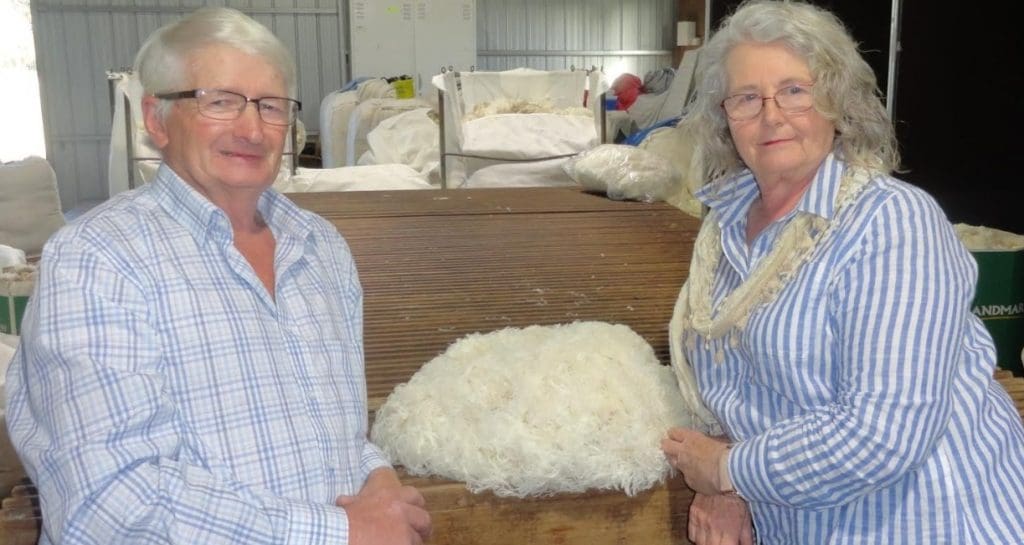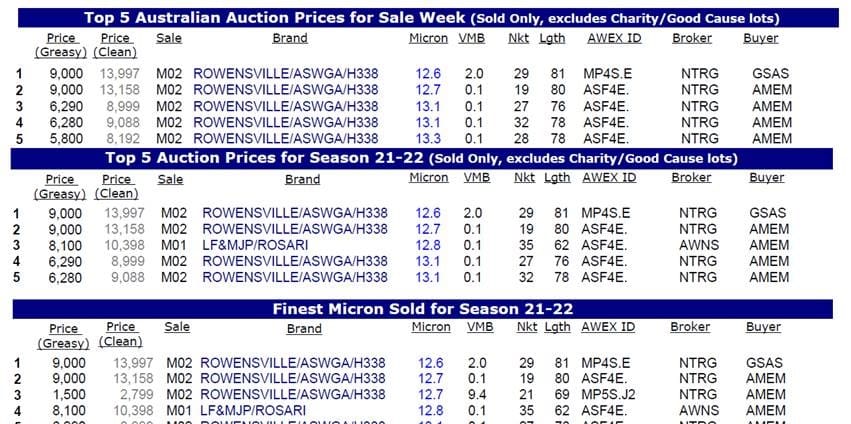
Ultrafine wool producers David and Susan Rowbottom with some of their award-winning wool.
NON-MULESED ultrafine Merino wool sold for up 9000c/kg for south-west Victorian growers this week in the highest Australian auction prices paid for several years.
In Melbourne, paddock-grown wool in the Rowbottom family’s 36-bale Rowensville offering tested as low as 12.7 micron and sold for up to 9000c/kg greasy, with all bales averaging just under $5000 and one 12.7 micron bale grossing more $14,000.
“It was a tremendous sale.”
St Helens grower David Rowbottom said the prices indicated there is a shortage of supply for the quality of wool being grown by him and wife Susan. Most of the wool sold to European buyers. Rowensville fleeces and lines have also been consistent winners in many awards offered by leading Italian processors.
“I found it unbelievable, we didn’t believe that it could make that much, it been some time since it has made any sort of high money,” Mr Rowbottom said.
The last time the Rowensville clip sold wool at auction for a higher price was 12,600c/kg for a specially prepared 14.3 micron bale in February 2008, he said.
“That’s been our highest price ever, this would be the second highest for paddock-grown wool.”
Mr Rowbottom believes the Rowensville wool attracted a premium because of its non-mulesed status. The flock stopped mulesing in 1979 and is working on Responsible Wool Standard certification.
“The wool brokers are starting to take it on now.”
The Rowbottom’s broker, Nutrien superfine wool specialist Ted Wilson, said the prices paid reflected the trend towards the wool industry now breeding bigger and broader sheep and fewer ultrafine growers.
“It’s a reflection of some recovery, but also of the lack of supply of these wools.
“I keep telling the exporters that there is not an endless supply of these wools and if they don’t take them now, don’t expect them to be there next week.
“You can count on one hand the number of wool growers in the country who can produce 13 micron wools in the paddock consistently – there are probably four or five who can do it.”
He said being able to produce sub-13 micron wool in the paddock reflected the depth of the breeding in the Rowensville sheep.
“I’m not sure if there have been any finer bales out of the paddock, but it (the 12.6 micron bale) was certainly one of the finest.”
Mr Wilson said these were the highest prices at auction since the late 2000s. The Australian Wool Exchange said the 8100c/kg greasy paid for a line of 12.8 micron Merino fleece wool last week was the highest price seen at auction in more than three years.
Mr Rowbottom said when he stopped mulesing the flock was producing short stapled wool with a diameter range of 19.3-20.4 micron. The decision to stop mulesing forced him to look into producing the right type of wool and skin on the sheep to avoid flystrike.
“It helped our selection towards a better quality, softer handling wool, and it’s longer stapled.
“I don’t know whether we would have ever achieved this if we hadn’t stopped mulesing, because I had to really work on getting it right,” he said.
This process had also helped the flock lower its average fibre diameter to 14.1 micron this year in a good season, he said.
“I think basically the first step in getting what we’ve got today was actually stopping mulesing.”
The flock’s average diameter is more than five microns finer and wool cut is slightly heavier than when the flock stopped mulesing, when the average cut was 3.14kg.
“I’m quite happy that we’ve been able to slightly increase the fleece weight along with taking the micron down by that much,” Mr Rowbottom said.
“We’re getting into an elite type of wool now, but we are just getting into another level now.”
Mr Rowbottom said he and his wife Susan and son Aaron have maintained their ultrafine wool flock despite lower prices in recent years, but were likely to increase production.
He said the latest clip diameter results – with weaner wool testing half a micron finer than last year – in a year when it was expected to be higher, indicated that selection and the quality of the rams being used was taking the flock to “another level.”
“That took us by surprise, as well as the price.”


Congratulations to the Rowbottom family from St Helens in south-western Victoria on another fine achievement. In Melbourne last week their paddock-grown wool clip of non-mulesed ultrafine Merino wool sold for up 9000c/kg and testing as low as 12.7 micron.
As David Rowbottom describes, his finer clip has emerged from his quest for a non-mulsed sheep that is free of breech wrinkle and is fly strike resistant.
The first Rowbottom grown fleece I ever saw was the fleece that won the Zegna prize and was on display at the 2017 IWTO meeting in Sydney. It measured 9.9 micron and was the most exquisite example of SRS-type wool I had ever seen. Well done and a salute to another family of wool artisans.